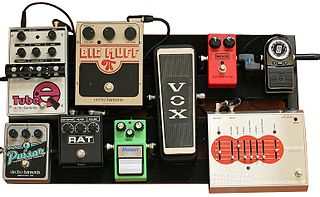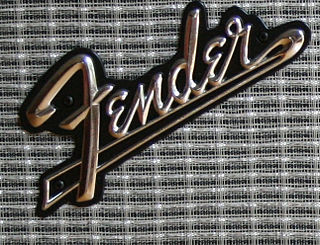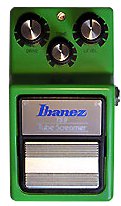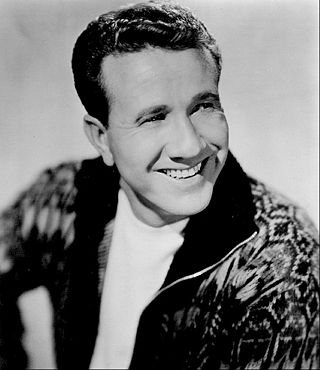
An effects unit, effects processor, or effects pedal is an electronic device that alters the sound of a musical instrument or other audio source through audio signal processing.

A guitar amplifier is an electronic device or system that strengthens the electrical signal from a pickup on an electric guitar, bass guitar, or acoustic guitar so that it can produce sound through one or more loudspeakers, which are typically housed in a wooden cabinet. A guitar amplifier may be a standalone wood or metal cabinet that contains only the power amplifier circuits, requiring the use of a separate speaker cabinet–or it may be a "combo" amplifier, which contains both the amplifier and one or more speakers in a wooden cabinet. There is a wide range of sizes and power ratings for guitar amplifiers, from small, lightweight "practice amplifiers" with a single 6-inch speaker and a 10-watt amp to heavy combo amps with four 10-inch or four 12-inch speakers and a 100-watt amplifier, which are loud enough to use in a nightclub or bar performance.

Boss is a manufacturer of effects pedals for electric guitar and bass guitar. It is a division of the Roland Corporation, a Japanese manufacturer that specializes in musical equipment and accessories. For many years Boss has manufactured a wide range of products related to effects processing for guitars, including "compact" and "twin" effects pedals, multi-effect pedals, electronic tuners and pedal boards. In more recent times, Boss expanded their product range by including digital studios, rhythm machines, samplers and other electronic music equipment. They also are now manufacturing solid-state amplifiers and speaker heads such as the Waza and the Katana. Both feature multi-effects units meant to emulate Boss' classic effects pedals.
Univox was a musical instrument brand of Unicord from the early 1960s, when they purchased the Amplifier Corporation of America of Westbury, New York, and began to market a line of guitar amplifiers. Univox also distributed guitars by Matsumoku, effects units by Shin-Ei Companion, and synthesizers by Crumar and Korg.

Fender amplifiers are a series of electric instrument amplifiers produced by the Fender Musical Instruments Corporation. The first guitar amplifiers attributed to Leo Fender were manufactured by the K&F Manufacturing Corporation (K&F) between 1945 and 1946. Later, Fender began building its own line of electric guitars. Fender amplifiers would become favorite of many famous guitarists such as Jimi Hendrix, Eric Clapton, and Stevie Ray Vaughan, also known in these cases for playing Fender guitars.

Electro-Harmonix is a New York City-based company that makes electronic audio processors and sells rebranded vacuum tubes. The company was founded by Mike Matthews in 1968. It is best known for a series of guitar effects pedals introduced in the 1970s and 1990s. EHX also made a line of guitars in the 1970s.

The Boss DS-1 is a distortion pedal for guitar, manufactured by the Roland Corporation under the brand name Boss since 1978. The first distortion effects unit made by Boss, it has become a classic effect, used by many notable guitar players.
Octave effect boxes are a type of special effects unit which mix the input signal with a synthesized signal whose musical tone is an octave lower or higher than the original. The synthesised octave signal is derived from the original input signal by halving (octave-down) or doubling (octave-up) the frequency. This is possible due to the simple two-to-one relationship between the frequencies of musical notes which are separated by an octave. One of the first popular musicians to employ the octave effect was Jimi Hendrix, who also used a variety of other effects in his recordings and public performances. Hendrix used an octave-fuzz pedal known as the octavia.

The Ibanez Tube Screamer is a guitar overdrive pedal, made by Ibanez. The pedal has a characteristic mid-boosted tone popular with blues, rock and metal players. The Tube Screamer has been used by many guitarists to create their signature sound, and is one of the most successful, widely copied, and custom-modified ("modded") overdrive pedals in the history of the electric guitar.

The Fuzz Face is an effects pedal for electric guitar, used also by some electric bass players. It is designed to produce a distorted sound referred to as "fuzz", originally achieved through accident such as broken electrical components or damaged speakers.

Distortion and overdrive are forms of audio signal processing used to alter the sound of amplified electric musical instruments, usually by increasing their gain, producing a "fuzzy", "growling", or "gritty" tone. Distortion is most commonly used with the electric guitar, but may also be used with other electric instruments such as electric bass, electric piano, synthesizer and Hammond organ. Guitarists playing electric blues originally obtained an overdriven sound by turning up their vacuum tube-powered guitar amplifiers to high volumes, which caused the signal to distort. While overdriven tube amps are still used to obtain overdrive, especially in genres like blues and rockabilly, a number of other ways to produce distortion have been developed since the 1960s, such as distortion effect pedals. The growling tone of a distorted electric guitar is a key part of many genres, including blues and many rock music genres, notably hard rock, punk rock, hardcore punk, acid rock, and heavy metal music, while the use of distorted bass has been essential in a genre of hip hop music and alternative hip hop known as "SoundCloud rap".

Bass effects are electronic effects units that are designed for use with an electric bass and a bass amplifier, or for an upright bass and a bass amp or PA system. Bass effects are commonly available in stompbox-style pedals, which are metal or plastic boxes with a foot-operated pedal switch or button which turns the effect on and off. Most pedals also have knobs to control the tone, volume and effect level. Some bass effects are available in 19" rackmount units, which can be mounted in a road case. As well, some bass amplifiers have built-in effects, such as compression, overdrive or chorus.
The Univox Super-Fuzz was a fuzzbox produced by the Univox company, primarily for use with the electric guitar or bass.
Tone Bender is the name of several fuzz distortion effect pedals.
BJFE Guitar Effects is a company which manufactures effects pedals for use with instruments such as an electric guitar. These pedals are commonly used by guitarists to modify the sound of their guitar before it reaches the amp. The company is located in Sweden, and was founded in 2000 by Björn Juhl. "BJFE" stands for Björn Juhl Förstärkarelektronik. Pedal types include distortion, overdrive, "vibe" (vibrato), compression, and equalization (EQ). Due to the limited production and handbuilt nature, these pedals are considered "boutique" guitar effects.

The Big Muff Pi (π), often known simply as the Big Muff, is a "fuzzbox" effects pedal produced in New York City by the Electro-Harmonix company, along with their Russian sister company Sovtek, primarily for use with the electric guitar. It is used by bassists as well, due to the Big Muff's squeaky frequency response.

Fuzz bass is a style of playing the electric bass or modifying its signal that produces a buzzy, distorted, overdriven sound, as the name implies. Overdriving a bass signal significantly changes the timbre, adds higher overtones (harmonics), increases the sustain, and, if the gain is turned up high enough, creates a "breaking up" sound characterized by a growling, buzzy tone.

Vintage musical equipment is older music gear, including instruments, amplifiers and speakers, sound recording equipment and effects pedals, sought after, maintained and used by record producers, audio engineers and musicians who are interested in historical music genres. While any piece of equipment of sufficient age can be considered vintage, in the 2010s the term is typically applied to instruments and gear from the 1970s and earlier. Guitars, amps, pedals, electric keyboards, sound recording equipment from the 1950s to 1970s are particularly sought. Musical equipment from the 1940s and prior eras is often expensive, and sought out mainly by museums or collectors.

The Maestro FZ-1 Fuzz-Tone was the first widely marketed fuzz distortion guitar and bass effect. Introduced in 1962, it achieved widespread popularity in 1965 after the Rolling Stones guitarist Keith Richards prominent use of the FZ-1 on the group's hit, "Satisfaction". Later in 1965 the design was slightly modified, designated as the model FZ1-1a. In the wake of the success of the Rolling Stones' "Satisfaction," numerous recordings mostly from 1960s garage rock and psychedelic acts featured Maestro Fuzz-Tones on guitars. More significant design changes made after 1967 resulted in different renditions of the Fuzz-Tone released over the years. In the 1990s Gibson re-issued FZ-1a, but it was later discontinued.











